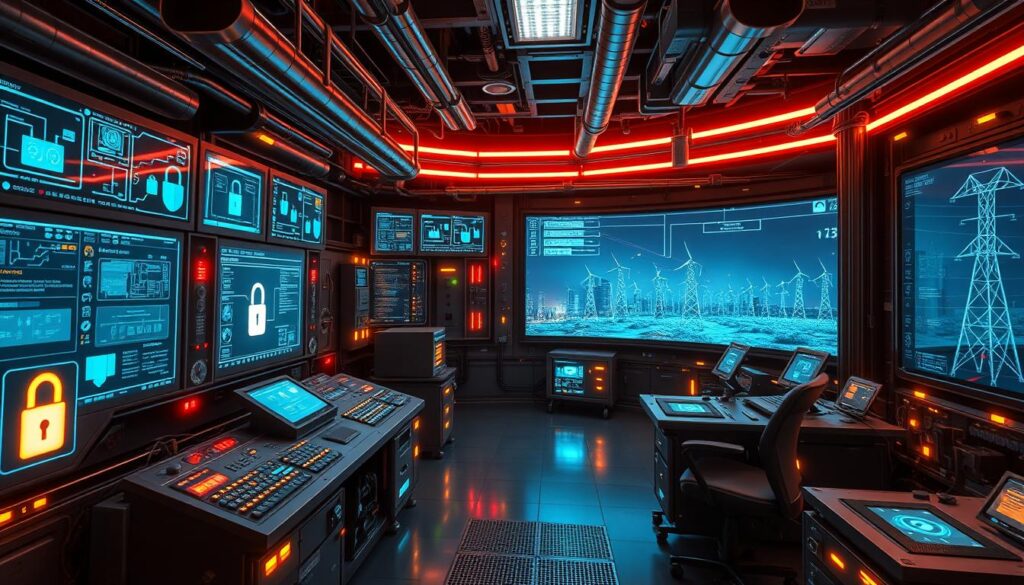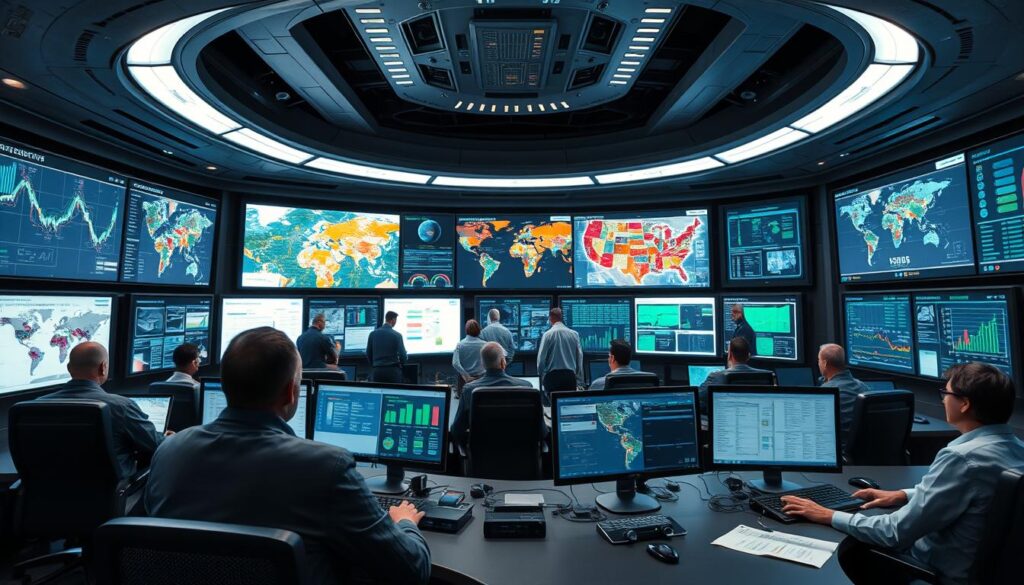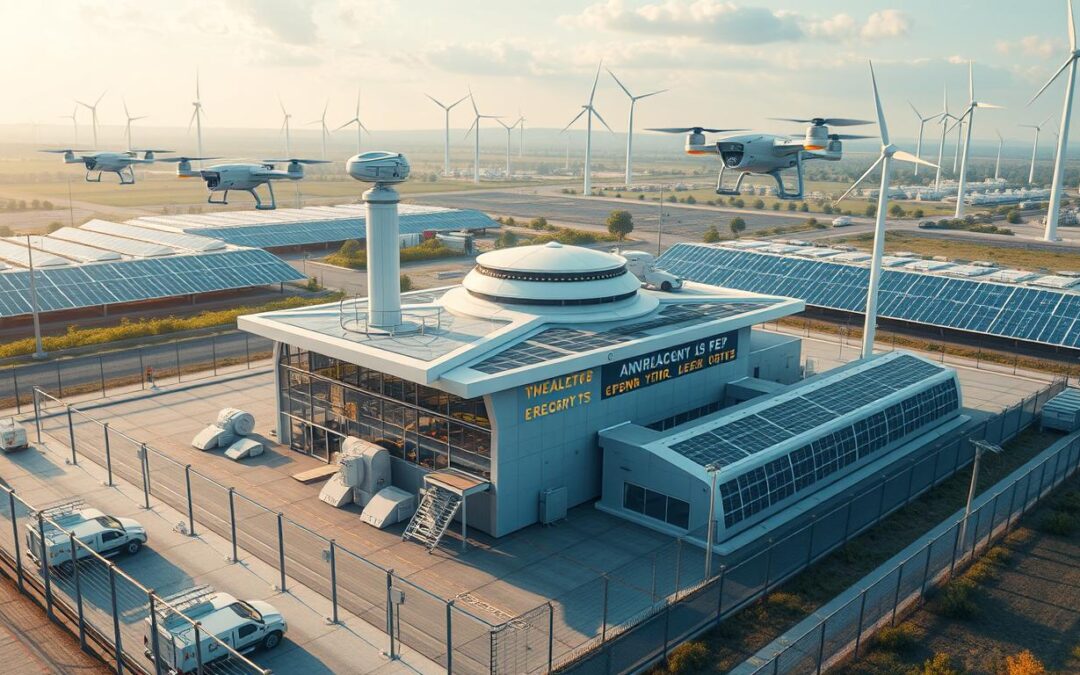The energy infrastructure is key to America’s economy and society. It powers our nation. But, it faces many cybersecurity threats. These threats could disrupt our lives.
From hacking to insider threats, the energy sector is at risk. Attacks could harm power grids, steal data, and threaten safety.
Securing our energy infrastructure is now a major concern. This article looks at the current state of energy security. It covers vulnerabilities, recent breaches, and changing rules.
We want to help leaders, policymakers, and the public. We aim to protect our energy lifelines with the right knowledge and strategies.
Key Takeaways
- The energy sector faces a growing array of cybersecurity threats that could disrupt power grids, compromise sensitive data, and jeopardize public safety.
- Securing America’s energy infrastructure has become a top national priority, as the critical system faces vulnerabilities and recent security breaches.
- The article explores the current state of energy security, including key vulnerabilities, recent security breaches, and the evolving regulatory landscape.
- Industry leaders, policymakers, and the public need to be empowered with knowledge and strategies to safeguard the nation’s energy lifelines.
- Comprehensive cybersecurity measures, public-private partnerships, and workforce development are essential for enhancing the resilience of the energy sector.
Understanding the Current State of Energy Infrastructure Security
The energy sector is facing many challenges to keep power grids stable and reliable. Cyber attacks on industrial control systems are getting more complex. Also, aging infrastructure poses physical risks. The industry must adapt quickly to these security threats.
Key Vulnerabilities in Energy Systems
The energy sector’s critical infrastructure is at risk from various threats. These include:
- Cyber attacks on industrial control systems that could disrupt power generation and distribution
- Physical attacks on substations, transmission lines, and other key facilities
- Extreme weather events and natural disasters that can damage energy infrastructure
- Insider threats from disgruntled employees or contractors with access to sensitive systems
Recent Security Breaches and Their Impact
The energy sector has seen many security breaches in recent years. These breaches have weakened grid resilience and exposed power grid vulnerabilities. For instance, the 2015 cyber attack on Ukraine’s power grid left hundreds of thousands without electricity.
The 2021 Colonial Pipeline ransomware attack showed how security incidents can affect the supply chain and economy.
Regulatory Landscape and Compliance Requirements
The energy industry must follow a complex set of regulations. These standards aim to improve the security of industrial control systems and critical infrastructure. However, keeping up with these changing rules is a big challenge for energy providers.
How to Remove the Cybersecurity Gridlock from the Nation’s Energy Lifelines
Securing the nation’s energy infrastructure is a big challenge. It needs a detailed plan to solve the cybersecurity gridlock in the energy sector. This plan should include using the latest cyber resilience strategies, training a skilled cybersecurity workforce, and making the grid more secure.
Using advanced cyber resilience strategies is key. This means setting up strong risk management systems, using real-time monitoring, and AI for threat detection. By finding and fixing weaknesses early, energy companies can better protect themselves from cyber threats.
Training the right people is also crucial. Programs and certifications can help energy workers learn to keep systems safe. Keeping these experts on board is just as important.
Boosting the grid security is essential too. This includes better physical security like access controls and cameras. It also means using the latest digital tools to stop hackers and catch problems fast.
Working together is vital. The government and private companies must team up. This way, the energy sector can use all the resources and knowledge needed to fight cyber resilience challenges.
It’s important to take a complete approach to cybersecurity in the energy field. This is the only way to protect our critical infrastructure and keep essential services running. By tackling the cybersecurity gridlock with smart plans, the energy sector can become more resilient and keep our communities powered.
Critical Infrastructure Protection Strategies for the Energy Sector
Protecting the nation’s energy infrastructure is key in today’s digital world. We need to cover both physical and digital weaknesses to fight cyber threats. The energy sector must use a layered approach to better protect its technology and infrastructure.
Physical Security Measures
Strong physical security is vital for keeping energy assets safe. This includes using advanced access control, watching with surveillance, and setting up strong defenses around the perimeter. By making the physical parts of energy systems stronger, we can stop unauthorized access and lessen the damage from attacks.
Digital Defense Systems
Digital systems are also crucial for the energy sector’s safety. We need to use strong cyber risk strategies, like dividing networks, making remote access secure, and catching threats as they happen. This helps keep digital assets safe and the energy system working right.
Emergency Response Protocols
Having good emergency plans is essential for when security is breached or a disaster hits. Energy companies need to have detailed plans for how to respond. These plans should cover how to communicate, recover, and manage crises. This helps keep the energy system running smoothly and quickly gets things back to normal.
By using these protection strategies, the energy sector can fight off cyber threats and keep energy flowing to businesses and communities across the country.
| Physical Security Measures | Digital Defense Systems | Emergency Response Protocols |
|---|---|---|
|
|
|
Strengthening Public-Private Partnerships in Energy Security
As energy sector cybersecurity threats rise, teamwork between government and private groups is key. Public-private partnerships are a strong way to tackle the tough issues in America’s energy system.
These partnerships use the strengths of both sides. They share threat intelligence and work on big security plans. This way, they make the energy sector stronger and safer.
- Models like the Cybersecurity and Infrastructure Security Agency’s (CISA) Joint Cyber Defense Collaborative show how well this works.
- They help energy companies get the latest threat info. This lets them fight off cyber attacks better.
- Also, these partnerships can bring in government help, money, and skills. This makes the energy sector’s security even stronger.
But, there are still hurdles to overcome. Issues like data privacy, legal problems, and trust issues stand in the way. We need to work hard to build trust, talk clearly, and agree on how to handle risks and emergencies.
“The energy sector is a critical pillar of our national infrastructure, and protecting it requires a unified, collaborative approach between the public and private sectors.”
By using public-private partnerships, the energy world can tap into the knowledge and resources needed. This helps keep the nation’s energy safe and the sector strong against new cyber threats.
Advanced Threat Detection and Response Systems
In today’s fast-changing cybersecurity world, energy operators need top-notch tech to fight new threats. Real-time monitoring, powered by AI, is key to protecting power grids and other vital energy assets from cyber threats.
Real-time Monitoring Solutions
Advanced real-time monitoring systems check network traffic and system logs non-stop. They use machine learning to spot potential security breaches and oddities. This lets them act fast to stop threats.
Artificial Intelligence in Threat Detection
AI and machine learning have changed how energy groups tackle security best practices. AI systems can handle huge data sets, find complex threats, and act on them alone. This makes incident response planning quicker and more precise.
Incident Response Automation
Automated incident response systems make handling security incidents easier. They help energy providers react quickly to cyber threats to power grids. These systems manage the whole incident response process, from start to finish. This cuts down on mistakes and ensures reliable security best practices.
| Technology | Key Features | Benefits |
|---|---|---|
| Real-time Monitoring Solutions |
|
|
| AI-powered Threat Detection |
|
|
| Incident Response Automation |
|
|
By using these advanced systems, energy groups can boost their security best practices. They become more resilient against cyber threats to power grids. This ensures their critical incident response planning runs smoothly and securely.
Building Resilient Industrial Control Systems
In the energy sector, industrial control systems (ICS) are key to our critical infrastructure. They power essential services and keep our energy systems running smoothly. But, these systems face big cybersecurity challenges that need a strong, proactive approach to industrial control systems security, cyber resilience, and critical infrastructure defense.
Securing ICS means understanding the operational technology (OT) world. Unlike IT systems, ICS often use old protocols and hardware, making them vulnerable to cyber threats. If attackers target these systems, they can cause big problems like power outages, affecting many people.
- Implement robust access controls and authentication mechanisms to prevent unauthorized access to ICS.
- Regularly patch and update ICS software and firmware to address known vulnerabilities.
- Establish comprehensive monitoring and incident response protocols to quickly detect and mitigate security incidents.
- Invest in specialized training for ICS operators and security personnel to enhance their ability to identify and respond to cyber threats.
By taking a comprehensive approach to ICS security, energy organizations can make their systems strong. They can handle and bounce back from cyber attacks, protecting the infrastructure that powers our lives.
“Securing industrial control systems is not just a technical challenge; it requires a deep understanding of the unique operational and regulatory landscape of the energy sector.”
As cyber threats grow, staying ahead of them is crucial. Energy companies must work together with government agencies, industry partners, and cybersecurity experts. This way, they can find new ways to protect their industrial control systems, keeping our critical infrastructure safe.

Cybersecurity Workforce Development and Training
In the energy sector, having a skilled cybersecurity team is crucial. As cyber threats grow, companies must fill the skills gap. They need to invest in training programs. This section looks at how to develop a strong cybersecurity team for energy companies.
Skills Gap Analysis
First, companies must do a skills gap analysis. This helps find out where more training is needed. It makes sure training meets the energy sector’s unique cybersecurity needs.
Training Programs and Certifications
- Training programs should cover network security, incident response, and protecting industrial control systems.
- Certifications like CISSP and CISM show a professional’s skills and knowledge.
- There should be ongoing learning chances, like workshops and webinars, to keep teams updated.
Retention Strategies for Security Professionals
Keeping good cybersecurity professionals is key. Companies can make their work environment better by:
- Offering good pay and benefits.
- Providing chances for career growth and learning.
- Encouraging innovation and improvement.
- Supporting work-life balance and mental health.
By focusing on workforce development and training, energy companies can create a strong security team. This team can protect critical infrastructure and handle new cyber threats.
“The most effective cybersecurity strategy is one that combines robust technological solutions with a highly skilled and motivated workforce.”
Implementing Risk Assessment and Management Frameworks
In the fast-changing energy sector, risk assessment strategies are key to protecting vital infrastructure from cyber threats. Energy providers use detailed risk management plans to spot and tackle cyber risk mitigation strategies. This helps keep the nation’s grid resilience strong.
The National Institute of Standards and Technology (NIST) Cybersecurity Framework is a well-known method. It helps organizations manage cyber risks with a five-step plan. This includes identifying, protecting, detecting, responding, and recovering from threats.
- Identify potential threats and vulnerabilities within the energy infrastructure
- Implement robust protection measures to safeguard critical systems and data
- Deploy real-time monitoring and detection capabilities to identify anomalies
- Establish comprehensive response and recovery plans to minimize the impact of incidents
- Continuously review and refine the risk management strategy to address evolving threats
By using these frameworks, energy providers can face the complex world of cybersecurity with confidence. They ensure the energy grid remains reliable and resilient.
“Effective risk management is not just about identifying and mitigating threats, but also about building organizational resilience and adaptability to ensure the continuity of critical energy services.”

It’s vital to include these risk-based methods in energy protection plans. This boosts the security of the nation’s energy systems against new cyber dangers.
Innovation in Energy Infrastructure Protection
The energy sector is facing new cyber threats. New technologies and security solutions are being developed. These aim to protect energy systems, make grids more resilient, and keep operational technology safe. This section looks at the latest advancements in energy infrastructure protection.
Emerging Technologies
The energy industry is using new technologies to get stronger. Artificial intelligence and machine learning help spot and fight cyber threats quickly. Advanced data analytics give a better view of network activities and weaknesses.
Blockchain technology is also being used. It makes energy transactions and grid operations more secure and reliable.
Future Security Solutions
The energy sector is set to use even more advanced security solutions. Quantum-resistant cryptography will protect energy systems from future threats. New ways to keep industrial control systems safe, like software-defined perimeters and zero-trust architectures, are also being explored.
Research and Development Initiatives
- Energy companies, schools, and government agencies are working together. They are creating new security tools and frameworks.
- They are testing new ideas like advanced microgrids and renewable energy storage. These aim to make grids more resilient.
- More money is being put into research and development. The focus is on securing critical infrastructure and training a skilled workforce.
| Emerging Technology | Application in Energy Security | Potential Benefits |
|---|---|---|
| Artificial Intelligence | Automated threat detection and response | Faster identification and mitigation of cyber threats, improved operational efficiency |
| Blockchain | Secure energy transactions and grid operations | Increased transparency, integrity, and tamper-resistance of energy data |
| Quantum Computing | Quantum-resistant cryptography | Future-proofing critical energy systems against emerging quantum-based attacks |
The energy sector is committed to innovation. This is leading to the development of advanced technologies and security solutions. These will be key in protecting critical energy infrastructure, securing operational technology, and making the nation’s power grid more resilient.
International Collaboration and Information Sharing
As cybersecurity threats grow, working together across borders is key. Public-private collaboration and threat intelligence sharing are vital for better energy sector cybersecurity.
Leading countries and groups have set up strong systems for sharing info. The Energy Security Operation Centre (ESOC) is a great example. It helps European energy groups share threat data and best practices.
- The ESOC helps watch for threats early and work together to fix problems. This makes Europe’s energy systems safer.
- In the U.S., the Industrial Control Systems Cyber Emergency Response Team (ICS-CERT) is a key player. It helps with international teamwork and sharing info between government and private companies.
Thanks to these efforts, energy companies can face new challenges better. This helps make the energy sector cybersecurity stronger overall.
| Initiative | Participating Countries/Regions | Key Focus Areas |
|---|---|---|
| Energy Security Operation Centre (ESOC) | Europe | Threat data sharing, best practice exchange, incident response coordination |
| Industrial Control Systems Cyber Emergency Response Team (ICS-CERT) | United States | International collaboration, information exchange, joint cybersecurity initiatives |
“Working together is crucial for keeping the energy sector safe from cyber threats. By joining forces, we can spot weaknesses, tackle problems fast, and make the global energy system stronger.”
Conclusion
The need to protect America’s energy sector from cyber threats is urgent. This article has looked at the main vulnerabilities, recent attacks, and the rules energy providers must follow. These steps are key to keeping the nation’s energy safe.
Energy companies can improve their defenses by using strong physical and digital security. They also need good emergency plans. Working together with the government and using advanced systems to detect threats are vital.
The energy industry must keep up with new technologies while making systems more secure. It’s important to have a skilled team to handle cybersecurity. Using risk management tools and sharing information globally will help the sector face cyber threats better.
FAQ
What are the current vulnerabilities in energy systems?
Energy systems have many vulnerabilities. These include old industrial control systems and complex supply chains. They also include the mix of operational and information technology. These weaknesses make energy systems vulnerable to cyber threats.
How have recent security breaches impacted the energy sector?
Recent security breaches have shown the damage cyber attacks can do. The Colonial Pipeline attack and the Ukraine power grid hack are examples. They have caused big disruptions, outages, and financial losses.
What are the key regulatory requirements for energy infrastructure protection?
The energy sector must follow strict rules. Organizations like NERC and NIST set these standards. Following these rules is key to keeping energy systems safe and reliable.
How can public-private partnerships help enhance energy security?
Working together is crucial for energy security. Government and private companies need to share information and coordinate. This helps protect critical energy infrastructure better.
What are the benefits of advanced threat detection and response systems?
Using advanced systems can greatly improve energy security. Real-time monitoring and AI for threat detection are key. These systems help spot threats early and respond quickly, making energy systems more resilient.
How can the energy sector address the cybersecurity workforce gap?
The energy sector needs more cybersecurity experts. To fix this, it should analyze skills gaps, create training programs, and keep good staff. This will help attract and keep skilled professionals.
What are the key elements of a robust risk assessment and management framework?
Good risk management in the energy sector is essential. It involves identifying and managing cybersecurity risks. This helps make informed decisions and allocate resources well, enhancing system resilience.
How can international collaboration and information sharing improve energy security?
Working together globally is vital for energy security. Sharing threat information and best practices helps everyone. This collective effort strengthens defenses and protects critical energy infrastructure worldwide.

